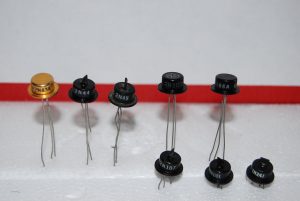 When I was young, my dad worked at National Technical Schools, a technical trade school that was world-famous. It offered correspondence courses in electronics all around the world — something that helped me start a stamp collection. One day he brought home a little plastic tube with a GE 2N107 transistor in it. Technically, he stole it but the reality was that while he knew a lot of electronics starting with amateur radio during the spark era (1BIP later to be W1BIP) and was, at the time, teaching television broadcasting, this “transistor thing” was new to him and something he was not ready to learn about. I also think that GE had given a bunch ot the school to encourage them to start doing things with transistors.
When I was young, my dad worked at National Technical Schools, a technical trade school that was world-famous. It offered correspondence courses in electronics all around the world — something that helped me start a stamp collection. One day he brought home a little plastic tube with a GE 2N107 transistor in it. Technically, he stole it but the reality was that while he knew a lot of electronics starting with amateur radio during the spark era (1BIP later to be W1BIP) and was, at the time, teaching television broadcasting, this “transistor thing” was new to him and something he was not ready to learn about. I also think that GE had given a bunch ot the school to encourage them to start doing things with transistors.
The photo at the right, from Wikimedia, shows early transistors. The fourth one from the left is a 2N107, GE’s entry into the “hobby transistor” market. And my entry as well. I had been building HeathKits, repairing TVs and radios and building stuff from scratch. My biggest issue was that it took so much time to build something because of all the overhead building with vacuum tubes: wiring the filaments, building the power supply and such. Thus, the transistor interested me as a quick way to build something and my dad was happy because I would do things with the transistor and he could learn from what I did helping he get current.
The 2N107 was actually “trash” (much like sodium fluoride which has found its way into tooth paste). GE made the 2N43, 44 and 45 transistors and the 2N107s were the rejects from the manufacture of commercial transistors. So, rather than having something for the trash bin, GE created a hobby market so they could sell their trash for $.99. Great marketing as this really did get a lot of people interested in transistors, including myself.
The 2N107 had impressive specifications such as:
- Maximum voltate: 12V
- Maximum current: 10 ma
- Maxumum operating frequency: 1 MHz
Thus, even using it as an amplifier at broadcast band frequencies (up to 1.6MHz at the time) was out of the question. Thus, practical use was pretty much as an audio amplifier as we weren’t ready to build digital circuits in 1960.
After I build the circuits from the specification sheet, I decided to get creative. I remember thinking that having something that could drive a NE-2 neon bulb would be cool as the only portable way to do it was buy some radio “B batteries” which were expensive. (You needed about 70 volts to drive a neon so it was either one 90 volt B battery or two 45 volt ones in series.)
In my junk box I found a small audio transformer designed to interface the plate circuit of a vacuum tube to a 4 or 8 ohm speaker. I figured that by using the low-impedance secondary as a primary and building an audio oscillator I could produce a relatively high voltage on what had been the primary. I didn’t care what frequency it would operate at so I built a hartley oscillator circuit which consisted of the 2N107, the transformer and a resistor to limit the base current of the transistor. The 4/8 ohm winding of the transformer was used as the tapped coil. I hooked up a 9 volt transistor radio battery and it actually oscillated as I could hear the transformer core ring. Hooking up my trusty HeathKit V7A VTVM I saw about 100 volts. Great.
I connected an NE-2 with a resior in series across the winding and it lit. Wow! But, the transistor was getting really hot. Clearly I was way over the 10 ma maximum collecot current. Knowing that the 2N107 might handle more current (clearly the specifications were set so a lot of the commercial transistor rejects would be good enough) I decided the solution was to add a heat sink (though I don’t think that word was used).
I had some aluminum scrap but saw no way to attach it to the 2N107. I scraped the black paint of the top of the transistor and found the case was made of copper. Wow, I could solder to it hopefully not destroying the germanium junction from excess heat. I took the top of a Littlefuse fuse box, scraped the paint off of part of it and soldered it to the top of the 2N107. It worked and I have my first “not by the book” transistor circuit.